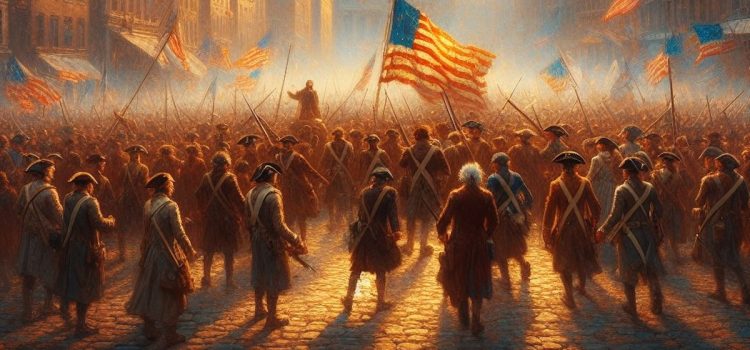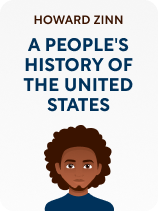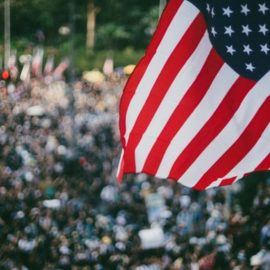

This article is an excerpt from the Shortform book guide to "A People's History of the United States" by Howard Zinn. Shortform has the world's best summaries and analyses of books you should be reading.
Like this article? Sign up for a free trial here.
What economic issues did American elites face in the years leading up to the American Revolution, and how did the war allow them to address these problems? How did poor whites, slaves, and American Indians respond to the war?
Howard Zinn titled Chapter 5 of A People’s History of the United States “A Kind of Revolution.” He characterizes America’s war for independence as a conflict between British and American elites rather than an uprising of the masses.
Continue reading to get Zinn’s take on the American Revolutionary War and the formation of the United States.
Chapter 5: “A Kind of Revolution” by Howard Zinn
While the colonial class system successfully repressed lower-class revolt, it didn’t stop elites from competing with one another. As such, Zinn argues in Chapter 5 (“A Kind of Revolution”) that the American Revolution was a conflict between British and American elites, not a popular uprising. In the years leading up to the war, American elites had two significant problems:
- Increased British taxes and tariffs were cutting into their profits.
- Class tension was growing among poor whites throughout the mid-18th century over horrible living and working conditions and low pay. Isolated revolts, riots, and rebellions became common: tenant farmers collectively refusing to pay rent, angry mobs storming stores and warehouses for food, and so on.
The American Revolution allowed American elites to address both of these problems: They recruited poor whites to fight the British instead of resisting the colonial class system. While many middle class and elite Americans believed in the ideals of the revolution—such as popular government and universal rights—they ultimately fought for their own benefit, not for any major redistribution of power or wealth between classes. The other classes were ambivalent about the war: Poor whites were either conscripted or joined the war because they needed money. Slaves mainly fought for Britain, who promised freedom in exchange for service. Indians also mostly fought for the British, as they had halted westward expansion.
(Shortform note: Some historians argue that the American Revolution was also fought to preserve slavery in colonial America. These historians note that, in the late 18th century, enslaved Africans throughout the Caribbean were participating in more and more organized and disorganized revolts. This growing unrest made the British consider abolishing slavery—they were concerned that a slave revolt combined with an enemy invasion could lose them their colonial possessions. Colonial elites responded with the American Revolution, fighting to ensure they could continue owning slaves. This theory also helps explain why so many enslaved people fought for the British during the Revolution in exchange for their freedom.)
Forming the US
After the colonists—aided in large part by the French—forced Britain to withdraw, they formally established the US in 1776. However, when it became clear there weren’t going to be major changes to the distribution of wealth, the same pre-war class tensions returned. Zinn explains that failures to pay Revolutionary War veterans their due wages, new taxes on the poor, and a weak government caused uprisings that threatened to destroy the power of the American elite.
It was in this context that a group of almost entirely white elite men came together to draft the US Constitution. They designed the document to secure their own class position, while conceding just enough power to the middle class to create a broader base of support. The Constitution did this through a number of systems: For example, it created a Supreme Court of justices appointed for life by the president instead of being elected. This ensured they didn’t have to be accountable to the electorate. In addition, the US Constitution distributed Senators equally among states rather than by population, which skewed power away from majority rule.
(Shortform note: Many authors of the US Constitution freely admitted they didn’t want the nation to be too democratic. Authors like Alexander Hamilton openly voiced his distrust of the public at large, believing they were too irrational and shiftless to run the country and that a class of elites needed to keep them in check. In The Federalist Papers, James Madison argued that the US Constitution needed to prevent majority factions from gaining too much power, arguing they would use it to infringe upon the rights of a minority—specifically citing the example of the poor infringing on the property rights of the rich by using the government to redistribute wealth.)

———End of Preview———
Like what you just read? Read the rest of the world's best book summary and analysis of Howard Zinn's "A People's History of the United States" at Shortform.
Here's what you'll find in our full A People's History of the United States summary:
- A bottom-up view of American history focusing on the people, not the politicians
- How Indigenous people, Black Americans, women, laborers, and activists lived
- Why social movements of the 60s and 70s failed to create lasting change







Comic books contain more historical accuracy and truth than Zinn’s book.
Consider this fact. The first African slaves that arrived in what would become the continental United States arrived wholly by chance.
The Spanish were transporting slave to the sugar cane fields and other settlement under Spanish control (primarily to settlements in what are now called central and south America).
The Portuguese slave ship São João Bautista was attacked by pirates, who during their escape, completely by chance landed at the Jamestown settlement.
Zinn an others leave the fact behind these 20 as the true founding of the United States. Implying that these 20 souls were always destined for Jamestown. This type of partial truth and out right false representation permeate “A People’s History.
Anyone touting Zinn’s fictional telling of history as he Interpret deserves to have all their work, as well as any credentials, questioned.